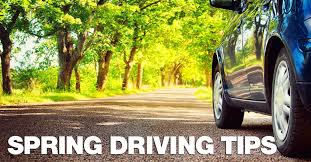Safe Driving Tips for Spring

Although winter is often viewed as the worst season for driving, Spring is not without its own unique set of hazards. In fact, the most recent data shows that rain causes more driving fatalities than snow in 39 of 50 U.S. States. Spring rains, combined with increased human and animal activity during this time can create an array of hazards. But with a bit of mindfulness and preparation, drivers can enjoy the roads during Spring’s warmer temps. Here are some potential dangers and how to avoid them:
Rain
While it’s true that Spring showers bring flowers, they can also create havoc on the roads.
Avoid driving through large puddles as this not only causes you to hydroplane but can also impair your brakes, obscure your vision and damage electrical system components.
Activity
Spring brings much activity – both human and animal. Watch for humans around the clock – but be especially vigilant of animals during the early morning and early evening hours when they are most active.
Potholes
Once winter’s snow, ice, and road salt have washed away, potholes form in their wake. Be on the lookout for these “criminal craters” and, if possible, try to navigate around them as contact with potholes can throw your car out of alignment.
Road Work
There’s a reason why early Spring is host to National Work Zone Awareness week. It’s this time of year when many workers are out on the roads fixing all of winter’s ravages so that drivers can navigate the roads safely. When approaching a work zone, be patient, slow down, and be on the lookout for that worker who is trying to make a living by improving our roadways.
Vehicles on Two Wheels
Warmer weather encourages both motorcyclists and bicyclists to enjoy the road. It is important to note that on most roads the same rights that apply to four-wheeled vehicles also apply to two-wheeled vehicles — so be sure to share the road. More importantly, motorcycles and bicycles may be more difficult to spot and easier to hide in blind spots so remain alert and anticipate the unexpected.
